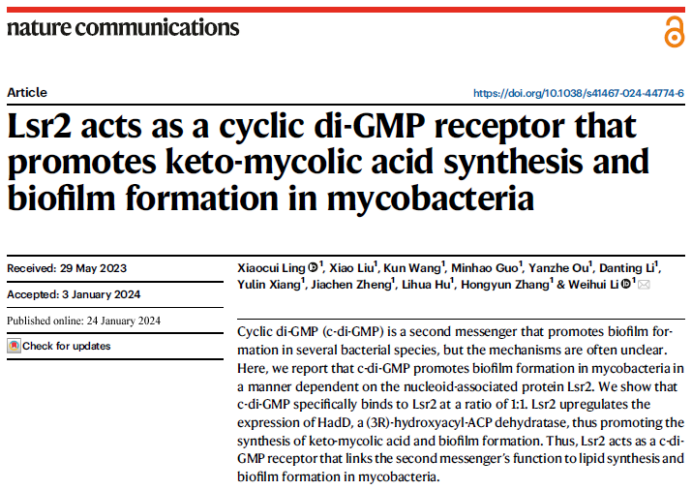Nature Communications | Professor Li Weihui's team has revealed a new regulatory mechanism of mycobacterium biofilm formation
Release time: 2024-02-26

Tuberculosis (TB) is a zoonotic infectious disease caused byMycobacterium tuberculosis (Mtb) complex group. It is the number one killer of single infectious diseases and has been a major global health concern. In recent years, with the emergence of multi-drug resistantMycobacterium tuberculosis, the prevention and control of tuberculosis has encountered unprecedented difficulties and challenges. Bacterial biofilm is an important physical barrier against external environmental stress, which can greatly improve the multidrug resistance of bacteria. Cyclic diguanosine monophosphoric acid (c-di-GMP) is a common second messenger and "star molecule" in bacteria, which regulates many physiological processes such as bacterial biofilm formation through downstream receptors. However, the molecular mechanism by which the signaling molecule c-di-GMP regulates the formation of mycobacterium biofilms is still unclear, and the relevant receptors have not yet been discovered.
Recently, Professor Li Weihui’s team from the College of Life Science and Technology of Guangxi University published an online paper entitled "Lsr2 acts as a cyclic di-GMP receptor that promotes keto-mycolic acid synthesis and biofilm formation in mycobacteria " in Nature Communications ", which discovered a new second messenger receptor Lsr2 and revealed that c-di-GMP promotes the synthesis of mycobacterial acid, a new molecular mechanism regulating the formation of bacterial biofilms.
The research team found that Lsr2 acts as a new receptor for the second messenger c-di-GMP, binding specifically in a 1:1 ratio. In addition, Lsr2 promotes the formation of bacterial biofilm by positively regulating the expression of (3R) -hydroxyacyl-ACP dehydratase (HadD), which mediates the synthesis of Keto-mycolic acid, a major component of mycobacterium cell wall. More interestingly, c-di-GMP can be used as an activator of Lsr2 to enhance the positive regulatory effect of Lsr2 on HadD. The above results will provide strategies for inhibiting multi-drug resistance of Mycobacterium tuberculosis by blocking cell wall lipid synthesis, and further provide theoretical basis for discovering new drug targets and developing novel vaccines against tuberculosis.
Ling Xiaocui, PhD candidate at Guangxi University, is the first author of the paper, and Li Weihui, College of Life Science and Technology, State Key Laboratory for Conservation and Utilization of Subtropical Agricultural Biological Resources, Guangxi University, is the corresponding author. The research was supported by the National Key Research and Development Program, the National Natural Science Foundation of China and the Guangxi Outstanding Youth Science Foundation, and was directed by Professor He Zhengguo of Guangxi University.
The article link: https://doi.org/10.1038/s41467-024-44774-6.